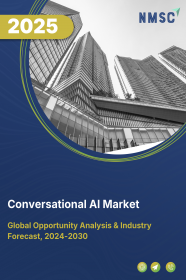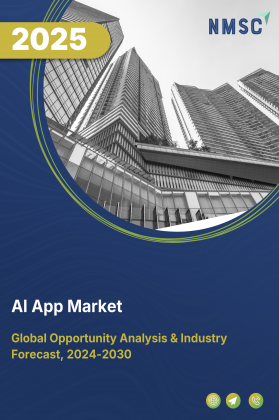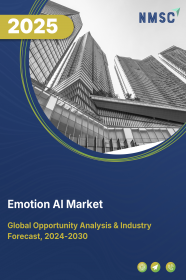
Conversational Artificial Intelligence (AI) Market by Type (Intelligent Virtual Assistants (IVA) and Chatbots), by Component (Platform, Services, Support and Maintenance, Training and Consulting, and System Integration), by Deployment (Cloud and On-premise), by Technology (Machine Learning, Deep Learning, Natural Language Processing (NLP), and Automated Speech Recognition), and Others - Global Opportunity Analysis and Industry Forecast, 2023–2030
Market Definition
The Conversational Artificial Intelligence (AI) Market size was valued at USD 9.16 billion in 2022, and is predicted to reach USD 47.69 billion by 2030, with a CAGR of 22.9% from 2023 to 2030.
Conversational AI refers to computer programs that use AI to enable interactions between humans and computers. They imitate human interactions by recognizing audio and text inputs and interpreting their meanings across several languages using big data, natural language processing, and machine learning. Additionally, conversational AI demands the integration of art and science to produce a digital application that integrates relevance, context, and personalization within a human-computer interaction.
Natural language processing (NLP) and machine learning are combined in conversational AI. NLP is made to work in a continuous loop with machine learning techniques to improve AI algorithms. Machine learning algorithms then increase their response quality over time as they learn. Furthermore, customers and companies have grown accustomed to the results of quick, improved, and round-the-clock customer assistance. Advanced technologies are helping businesses enhance customer satisfaction, reduce expenses, and increase profits. With new AI developments, product managers have access to the tools needed to create an effective Intelligent Virtual Assistant (IVA).
Market Dynamics and Trends
The rapidly rising demand for AI-powered customer support, omni-channel deployment, and reduced chatbot development costs in call centers, websites, emails, and applications drive the growth of the conversational AI market. Moreover, the rapid uprooting of current mobile and web applications by speech-based and AI-powered messaging apps is predicted to lead to the emergence of a new form of communication. This, in turn, boosts the conversational AI market growth.
In addition, the introduction of regional language support into conversational AI systems is significantly gaining popularity worldwide. For instance, Google added the support for seven additional languages for activities on Google Assistant. With this update, Google now offers support for 16 different languages. Furthermore, the growth of the market is driven by the emergence of advanced conversational AI capabilities, which are employed to provide services such as addressing frequently asked questions (FAQs) in an efficient and user-friendly manner.
For instance, in November 2021, Google launched Bot-in-a-Box coupled with conversational AI. This new feature from Google Cloud makes it easier for companies to launch chatbots using existing customer FAQs. It allows companies to connect with people via Google Search, Google Maps, or their own business channels.
However, the lack of awareness about conversational AI solutions coupled with high initial installation costs and constant update requirements are expected to restrain the market growth during the forecast period. On the contrary, the increasing penetration of natural language processing (NLP) and technological advancements in conversational AI such as gesture and recognition features are expected to create ample growth opportunities for the market in the coming years. For instance, in August 2021, Conversational AI platform provider Yellow.ai announced the funding of USD 78.1 million to expand its AI-based chatbot platform with NLP across the globe.
Market Segmentations and Scope of the Study
The conversational AI market is segmented on the basis of type, component, deployment, technology, organization size, mode of integration, business function, application, end user, and geography. On the basis of type, the market is divided into intelligent virtual assistants (IVA) and chatbots. On the basis of component, the market is classified into platform, services, support and maintenance, training and consulting, and system integration. On the basis of deployment, the market is categorized into cloud and on-premise. On the basis of technology, the market is segmented into machine learning, deep learning, natural language processing (NLP), and automated speech recognition. On the basis of organization size, the market is bifurcated into large enterprises and small and medium-sized enterprises (SMEs). On the basis of mode of integration, the market is divided into web-based, app-based, and telephonic. On the basis of business function, the market is classified into sales and marketing, finance, human resource, operations, and IT service management. On the basis of application, the market is categorized into customer support, personal assistant, branding and advertisement, customer engagement and retention, onboarding and employee engagement, data privacy and compliance, and others. On the basis of end user, the market is segmented into BFSI, retail & e-commerce, healthcare & life science, travel & hospitability, IT & telecom, automotive, media & entertainment, and others. The geographical breakdown and analysis of each of the aforesaid segments include regions such as North America, Europe, Asia-Pacific, and RoW.
Geographical Analysis
The conversational AI market is dominated by North America, and this dominance is anticipated to continue during the forecast period. This is attributed to factors such as the rapid adoption of conversational AI-based chatbots as customer service agents by companies in the healthcare sector. In North America, the healthcare industry is expanding to incorporate robotics, AI, and augmented and virtual reality. This would support the provision of knowledgeable services and technologies for evidence-based healthcare with a focus on preventive and collaborative care.
For instance, in April 2021, Microsoft Corporation acquired Nuance Communications for USD 19.7 billion to enhance its voice recognition and transcription technology. This will empower healthcare beneficiaries with the power of ambient clinical intelligence and other Microsoft’s cloud services. This acquisition was made possible with the Nuance's relationships and expertise with electronic health record (EHR) system providers and the combination of Nuance's solutions with Microsoft Cloud for Healthcare.
Moreover, the presence of various prominent companies, such as Google, Microsoft Corporation, IBM, and Nvidia that are engaged in conversational AI technology, boosts the growth of the market in this region. For instance, in March 2021, Google Cloud announced the availability of Vertex AI, which is a managed machine learning (ML) platform aimed at speeding up the deployment and maintenance of organizational AI models. Vertex AI is used for various tasks such as natural language processing, computer vision, and time series, and can be used in a wide range of industries such as healthcare, retail, government, and others.
On the other hand, Asia-Pacific conversational AI market is growing significantly with many companies and startups developing and deploying conversational AI solutions across various industries including e-commerce, BFSI, healthcare, and others. The growing developments and innovations in this field that can be further optimized on cloud services drive the growth of the conversational AI market in this region. For instance, in February 2021, Kore.ai, a U.S.-based conversational AI software company, launched its Japanese virtual assistant platform that is cloud-compatible. It enables customers in Japan to access the platform through Amazon Web Services (AWS).
This conversational AI technology allows people to communicate with businesses, systems, and devices in a natural and conversational way using tools such as text and voice assistants. Developers can use technologies such as AI, machine learning, deep learning, and predictive analytics to create these virtual assistants. Moreover, the rapidly growing adoption of intelligent virtual assistants (IVAs) in the BFSI sector to improve the conversational capabilities with customers fosters the growth of the market.
For instance, in March 2022, ICICI Lombard, an India-based insurance company, launched a chatbot called Responsive Intelligent Assistant (RIA) to improve customer experience. The chatbot has a human-like avatar and can communicate in English and Hindi. It uses advanced technology, including natural language processing and an Intent Mining Module, to provide the best interaction experience.
Competitive Landscape
Various players operating in the conversational AI market include Amazon Web Services (AWS), Google LLC, Microsoft Corporation, IBM Corporation, SAP SE, Baidu, Inc., Alibaba Group Holdings, Ltd., Salesforce, Inc., Artificial Solutions, Oracle Corporation, Fidelity National Information Services, Inc., Kore.ai, Inc., OpenAI, Nuance Communications, Conversica, Inc., and others. These market players are adopting various strategies such as product launches across various regions to maintain their dominance in the market.
For instance, in November 2021, ZeroShotBot unveiled a revolutionary conversational AI technology that makes it possible for businesses of all sizes to easily create chatbots. With ZeroShotBot, chatbots can be created quickly and scaled within hours without the need for coding skills or training data. This innovative technology democratizes the chatbot-building process, making it accessible to everyone.
In addition, in April 2021, NVIDIA announced the release of NVIDIA Jarvis, a framework that offers developers advanced and pre-trained deep learning models and software tools for the development of interactive conversational AI suitable for any industry. NVIDIA Jarvis features highly-accurate automatic speech recognition, unparalleled language understanding, multilingual real-time translations, and new text-to-speech capabilities to create highly expressive conversational AI agents. With NVIDIA Jarvis, developers will be able to create new language-based applications that were previously not possible, enhancing human-machine interactions.
Key Benefits
-
The conversational AI market report provides a quantitative analysis of the current market and estimations from 2023 to 2030. This analysis assists in identifying the prevailing market opportunities to capitalize on.
-
The study comprises of an extensive analysis of the conversational AI market trends, including the current and future trends for depicting the prevalent investment pockets in the market.
-
The information related to key drivers, restraints, and opportunities and their impact on the conversational AI market is provided in the report.
-
The competitive analysis of the market players along with their market share in the conversational AI market is mentioned.
-
The SWOT analysis and Porter’s Five Forces model are elaborated in the study.
-
The value chain analysis in the market study provides a clear picture of the stakeholders’ roles.
Key Market Segments
By Type
-
Intelligent Virtual Assistants (IVA)
-
Chatbots
By Component
-
Platform
-
Services
-
Support and Maintenance
-
Training and Consulting
-
System Integration
By Deployment
-
Cloud
-
On-premises
By Technology
-
Machine Learning
-
Deep Learning
-
Natural Language Processing (NLP)
-
Automated Speech Recognition
By Organization Size
-
Large Enterprises
-
Small and Medium-Sized Enterprises (SMEs)
By Mode of Integration
-
Web-based
-
App-based
-
Telephonic
By Business Function
-
Sales and Marketing
-
Finance
-
Human Resource
-
Operations
-
IT Service Management
By Application
-
Customer Support
-
Personal Assistant
-
Branding and Advertisement
-
Customer Engagement and Retention
-
Onboarding and Employee Engagement
-
Data Privacy and Compliance
-
Others
By End User
-
BFSI
-
Retail & E-commerce
-
Healthcare & Life Science
-
Travel & Hospitability
-
IT & Telecom
-
Automotive
-
Media & Entertainment
-
Others
By Geography
-
North America
-
U.S.
-
Canada
-
Mexico
-
-
Europe
-
UK
-
Italy
-
Germany
-
Spain
-
Netherlands
-
Rest of Europe
-
-
Asia-Pacific
-
China
-
Japan
-
India
-
Australia
-
South Korea
-
Taiwan
-
Vietnam
-
Rest of Asia Pacific
-
-
RoW
-
Latin America
-
Middle East
-
Africa
-
REPORT SCOPE AND SEGMENTATION:
|
Parameters |
Details |
|
Analysis Period |
2022–2030 |
|
Base Year Considered |
2022 |
|
Forecast Period |
2023–2030 |
|
Market Size Estimation |
Billion (USD) |
|
Market Segmentation |
By Type (intelligent virtual assistants (IVA) and chatbots), By Component (platform, services, support and maintenance, training and consulting, and system integration), By Deployment (cloud and on-premise), By Technology (machine learning, deep learning, natural language processing (NLP), and automated speech recognition), By Organization size (large enterprises and small and medium-sized enterprises (SMEs)), By Mode of Integration (web-based, app-based, and telephonic), By Business Function (sales and marketing, finance, human resource, operations, and IT service management), By Application (customer support, personal assistant, branding and advertisement, customer engagement and retention, onboarding and employee engagement, data privacy and compliance, and others), By End User (BFSI, retail & e-commerce, healthcare & life science, travel & hospitability, IT & telecom, automotive, media & entertainment, and others) |
|
Geographical Segmentation |
North America (U.S., Canada, Mexico) Europe (UK, Italy, Germany, Spain, Netherlands, Rest of Europe) Asia-Pacific (China, Japan, India, Australia, South Korea, Taiwan, Vietnam, Rest of Asia Pacific) RoW (Latin America, Middle East, Africa) |
|
Companies Profiled |
Amazon Web Services (AWS), Google LLC, Microsoft Corporation, IBM Corporation, SAP SE, Baidu, Inc., Alibaba Group Holdings, Ltd., Salesforce, Inc., Artificial Solutions, Oracle Corporation, Fidelity National Information Services, Inc., Kore.ai, Inc., OpenAI, Nuance Communications, Conversica, Inc., and others |
KEY PLAYERS
-
Amazon Web Services (AWS)
-
Google LLC
-
Microsoft Corporation
-
IBM Corporation
-
SAP SE
-
Baidu, Inc.
-
Alibaba Group Holdings, Ltd.
-
Salesforce, Inc.
-
Artificial Solutions
-
Oracle Corporation
-
Fidelity National Information Services, Inc.
-
Kore.ai, Inc.
-
OpenAI
-
Nuance Communications
-
Conversica, Inc.




















 Speak to Our Analyst
Speak to Our Analyst

























